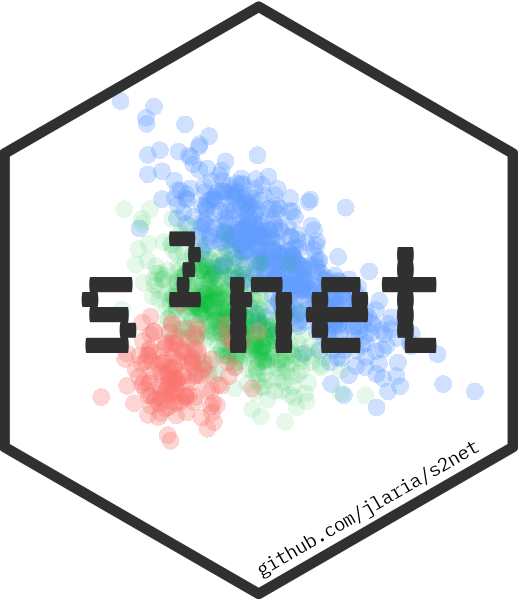
The hardware and bandwidth for this mirror is donated by dogado GmbH, the Webhosting and Full Service-Cloud Provider. Check out our Wordpress Tutorial.
If you wish to report a bug, or if you are interested in having us mirror your free-software or open-source project, please feel free to contact us at mirror[@]dogado.de.

R package s2net
s2net in R, written in C++ using RcppArmadillo and integrated into R via Rcpp modules.You can install the released version of s2net from CRAN with:
The development version can be installed with:
This is a basic example which shows you how to use the package. Detailed examples can be found in the documentation and vignettes.
Semi-supervised data is made of a labeled dataset xL, the labels yL, and unlabeled data xU. Package s2net includes the function s2Data to process semi-supervised datasets.
head(auto_mpg$P2$xL, 2) # labeled data
#> displacement horsepower weight acceleration year origin
#> 15 113 91 2372 15.0 70 3
#> 19 97 84 2130 14.5 70 3
head(auto_mpg$P2$yL, 2) # labels
#> [1] 24 27
head(auto_mpg$P2$xU, 2) # unlabeled data
#> displacement horsepower weight acceleration year origin
#> 1 307 17 3504 12.0 70 1
#> 2 350 35 3693 11.5 70 1
train = s2Data(auto_mpg$P2$xL, auto_mpg$P2$yL, auto_mpg$P2$xU, preprocess = TRUE)
head(train$xL, 2)
#> displacement horsepower weight acceleration year origin2
#> 15 0.1788500 1.0544632 0.1799762 -0.6392182 -1.878311 -0.6575667
#> 19 -0.5510247 0.7397884 -0.5209896 -0.8471591 -1.878311 -0.6575667
#> origin3
#> 15 1.356622
#> 19 1.356622The data is centered and scaled, and factor variables are automatically converted to numerical dummies. Constant columns are also removed. If we wanted to use validation/test data, we must pre-process it according to the training data, with:
There are two ways to fit a semi-supervised elastic-net using s2net. The easiest way is using the function s2netR, that returns an object of S3 class s2netR.
model = s2netR(train, params = s2Params(lambda1 = 0.01, lambda2 = 0.01, gamma1 = 0.01, gamma2 = 100, gamma3 = 0.1))
class(model)
#> [1] "s2netR"
model$beta
#> [,1]
#> [1,] -0.28152012
#> [2,] 0.04116177
#> [3,] -3.02848437
#> [4,] 0.61602553
#> [5,] 3.65674054
#> [6,] 0.71547766
#> [7,] 0.43169913
ypred = predict(model, valid$xL)If we are fitting the semi-supervised elastic-net many times, using the same train data (for example, searching for the best hyperparameters), then it is faster to use the C++ class s2net instead.
obj = new(s2net, train, 0) # 0 = linear
# We fit the model with
obj$fit(s2Params(0.01, 0.01, 0.01, 100, 0.1), 0, 2) # frame = 0 (ExtJT), proj = 2 (auto)
obj$beta
#> [,1]
#> [1,] -0.28700933
#> [2,] 0.04228791
#> [3,] -3.02580178
#> [4,] 0.61559052
#> [5,] 3.65723926
#> [6,] 0.71451133
#> [7,] 0.43040118
ypred = obj$predict(valid$xL, 0) #0=default predictions
# or
ypred = predict(obj, valid$xL)
#> Warning in if (class(newX) == "s2Data") {: the condition has length > 1 and only
#> the first element will be usedMore examples can be found in the package documentation and vignettes.
These binaries (installable software) and packages are in development.
They may not be fully stable and should be used with caution. We make no claims about them.
Health stats visible at Monitor.